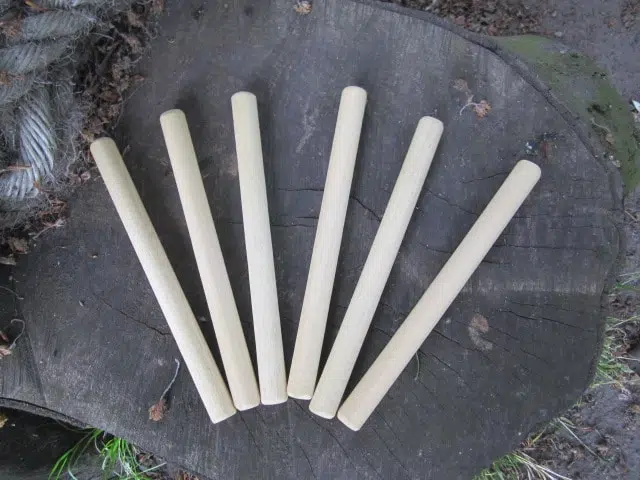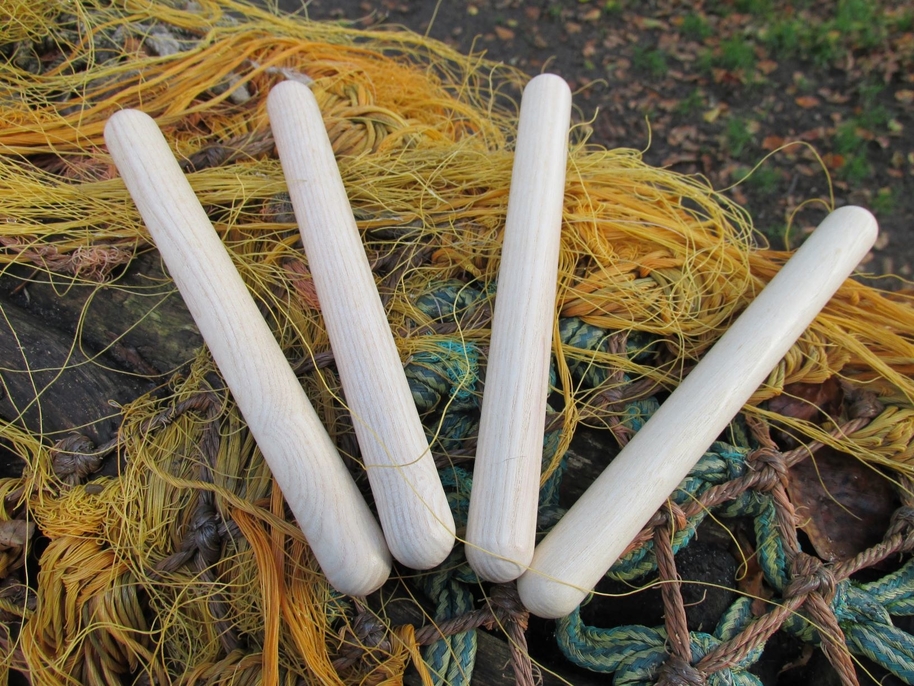I have to say that if I could select just one resource to take from my classroom, it would undoubtedly be claves, or ‘rhythm sticks’ as we like to call them. Rhythm sticks are simply long pieces of broomstick-like wood, cut into about 8-inch sections and the ends sanded down. You can use claves, but the ones I use with the children are home-made.
There are so many games that you can play with rhythm sticks, and they cover so many areas of the curriculum – maths, language, storytelling, and early phonics in particular.
But what sort of games can you play?
Rhythm sticks are fantastic for playing a range of early phonics games. All phonic aspects and skills can be covered. They are really good at beating in time with a song or chant, and this helps children think about the rhythm in words. They are also fantastic for hitting the syllables in words, such as ‘a-pple! 1-2!’ Rhythm sticks can also be used to learn about musical vocabulary and explore sounds. They can be used for simple segmenting.
I also find rhythm sticks fantastic for behaviour. If anyone is messing around with them, I always remove the sticks for a minute or so. Most children are extremely anxious to get them back, so will hopefully mend their ways!
Here are some of my favourite games. All of these games could also be played using clapping, drums or bells, but rhythm sticks are my favourite…

1. Chop chop choppety chop
Have a bag of pretend (or real) food. Teach the following chant and show children how to use the rhythm-sticks to keep a beat:
Chop, chop, choppety chop,
Chop off the bottom and chop off the top.
You can either hit the sticks together on the beat of the chant, or hit the syllables of the words as you say them.
Then get a child to pick out a piece of food and together practice hitting the syllables of the word with the sound-sticks, e.g. ‘straw-ber-ry. 1-2-3!’ Another might be ‘car-rot! 1-2!’ Repeat each word so they really get the idea.
I always follow the formula of hit two pieces of food, and then sing the chant, two pieces of food, and continue repeating. Songs and chants are good to get into quick phonic activities as they bring back the attention of those that may have wandered off slightly during the previous minute.
2. Other types of syllables games
The Chop Chop game is a great syllables game, but it is far from being unique. (To find out 17 fantastic syllables games you can also check this article out).
Pretty much anything could be put into a bag, and brought out for the children to hit its name with rhythm-sticks. I like to do the syllables game with vehicles. You can, for example, put in simple items like a ‘truck’ (1 hit), or much harder ones like a ‘combine harvester’ (5 hits).
I also like to incorporate well-known chants and songs. I like to have a bag of jungle animals and then all sing the chant:
Walking through the jungle, walking through the jungle,
What do I see? What do I see?
Take out an animal, and all hit it’s name with the rhythm-sticks, e.g. go-ril-la! 1-2-3!’ You can make it even more fun by using voices like the animal, e.g. hissing the word ‘sssnake! 1!’
Other good objects for putting in the bag are dinosaurs (particularly for your more able children), farm animals and nursery rhyme characters.
3. Segment words
This is a great quick activity, that can be thrown in for just half a minute whenever you are using the sticks, (supposing the children are ready for this slightly harder skill).
Give the children are simple CVC word, or show them a CVC picture. Get them all to hit three times whilst saying the sounds in the word, e.g. H-o-t. Hot! H-o-t! Hot!’ Always repeat words a few times when doing harder skills such as blending and segmenting.
To find out an in-depth guide of what segmenting is (and the best ways to teach it) then check this out.
4. Copy the rhythm
This game can take a bit of practice, but is great for several skills, including auditory sequential memory (the skill of hearing sounds in an order and remembering that order).
To start, have the children sat in a circle.
Then the adult will begin the game by giving them a rhythm on the sticks. It could be two quick taps, then a pause, and then another hit. Then the children try to copy the rhythm. Repeat with different rhythms.
When the children get good at doing this version of the game, you can move on to the slightly harder version.
Go around the circle, and each child in turn has a go at creating a rhythm. The others copy. It is a good idea to limit it to 3 or 4 hits to start with, but see how you get on, and if the children become really good at it then extend to more hits.
This is a great example of a game that really promotes eye-contact. To check out many more eye-contact games then take a look at this.
5. Copy the rhythm body percussion
This game is similar to ‘Copy the Rhythm’ but also has the added element of using body percussion.
Body percussion is simply the different noises that parts of our bodies make when you hit them. So, for example, if you hit the sole of your shoe with a rhythm stick, it makes a much harder and louder sound than if you tap your thigh.
To start with the adult will create a rhythm. It could be one tap of the shoe, one of the thigh and one of the floor. The children copy.
Repeat a few different rhythms, and then once again let the children take turns to copy each other in turn.
Again, it is advisable to stick to maybe three hits the first time you play this game. This activity is great for developing memory, auditory sequential memory, and also awareness of the texture and quality of sounds. Warning – don’t hit your teeth or eyes! (Check out some other amazing memory games here)

6. Hit the phrase
This game is great for beginning the process of thinking about writing sentences later on. When children begin to write sentences, they will be beginning to break the flow of speech into words.
One skill I always teach at this point is counting the number of words in the sentence you are about to write.
This game is a great precursor to that. Select a simple phrase, e.g. ‘Go to the park’. Say the phrase, whilst hitting each word with the rhythm sticks, and then count it, once again hitting each number.
For example, say and hit, ‘Go to the park. 1-2-3-4!’ Another example could be ‘Zip up your coat. 1-2-3-4!’ You could literally use any phrase!
Get the children to make up some sentences or phrases, and hit them together. This game is also good to throw into your daily routine (maybe not using sound sticks, but just clapping). You can tell children things like ‘Wash your hands. 1-2-3!’
7. Use a music doll
Any toy or doll will work fine for this. I like to use a baby toy that has musical instruments attached to her.
The music doll whispers in your ear and tells everyone how to play the rhythm sticks. For example, she will say, ‘Play them quietly.’ The children have a go. She might also say, ‘Play them loudly, or play them quickly.’
This game is excellent for teaching musical vocabulary, and also experimenting with sound.
When the children are getting good at playing using one musical word, you can extend them by using two words. This adds an element of memory and also multi-tasking.
The doll can say things like, ‘Play them loudly and quickly.’ The children copy. If the children are OK at this, the next step is to introduce three words. A good example of this would be ‘Play them loudly and slowly and angrily.’
Another way to extend this game is use more unusual words, such as ‘rapidly’, ‘pianissimo’, and ‘furiously’.
It is amazing how the introduction of one simple toy or puppet can really inspire children. To find out the ultimate 22 teaching activities using puppets, then take a look at this.
8. The classic name game
Children really love this game, and it is one of the best ways to get them to think about rhythm and syllables in words.
Get each child in the circle to say their name, and hit each syllable with the rhythm sticks. For example, they say, ‘E-bo-ny. 1-2-3.’ Then everyone else copies. Continue around the circle in turn.
The extension of this game is to use surnames, or even middle names and surnames. For example, Ebony’s full name might be, ‘E-bo-ny-Mai-sie-Col-lins. 1-2-3-4-5-6-7!’ Quite a challenge, but it’s always nice to know there is a next step to any activity if required.
9. Make up a story
This is my number one favourite strategy for using rhythm sticks.
To start with it is probably best if the adult makes up the story, and the children help to bring it to life using the rhythm sticks for sounds effects and also to add visuals.
When the children gain confidence, however, then you can start to get them to make up the story, and just support them in creating sound effects and keeping order!
An example of a story might be something like…
‘One day the ferocious dragon woke up in his dark cave. He stamped across the cave to the other side (stamp stamp stamp – hitting the sticks with each stamp). He roared a terrible roar – (roar roar roar).
He swung open the door of the cave with a crrrreeeeaakkk. He saw a hillside (use the sticks to make a triangle hillside). On the hillside were some steps (use them to make steps going down a hill.) Down the hillside came the beautiful princess, her high heels going clip clip clip down the steps.’
Just keep going! When the children get involved you normally get all sorts of bloodshed and crazy characters getting involved.
To find out many more fantastic storytelling strategies then check these two articles out:
The Essential Guide On How To Use Story Stones
How To Use Story Spoons (10 Ideas With Pics)
10. Hit refrains in a well-known story
This strategy works really well for well known traditional tales such as the Three Little Pigs. It also is great for any story that has a repeated line or refrain in it, such as ‘There’s a shark in the park!’ Whenever that line comes up in the book, get the children to join in and also hit the words with their rhythm sticks.
Traditional tales supply lots of these repeated lines, such as ‘Fee fi fo fum!’ Or ‘I’ll huff and I’ll puff and I’ll blow your house down!’ But there are also many modern picture books that have lines that can be brought to life in this way.
Conclusion
Rhythm sticks are one of the best tools to aid in teaching the early skills in phonics. They are fantastic for teaching rhythm, and getting children to think about the syllables in words. They are also good for exploring musical rhythm and body percussion.
Rhythm sticks can be used to segment and also hit the number of words in a sentence. All in all, a fantastic resource that is cheap to make but will last a lifetime.
If you have found this article useful, why not check out one of these:
Alliteration Activities – Ten Terrific Ideas
What Is Blending In Phonics? A Guide For Teachers And Parents
